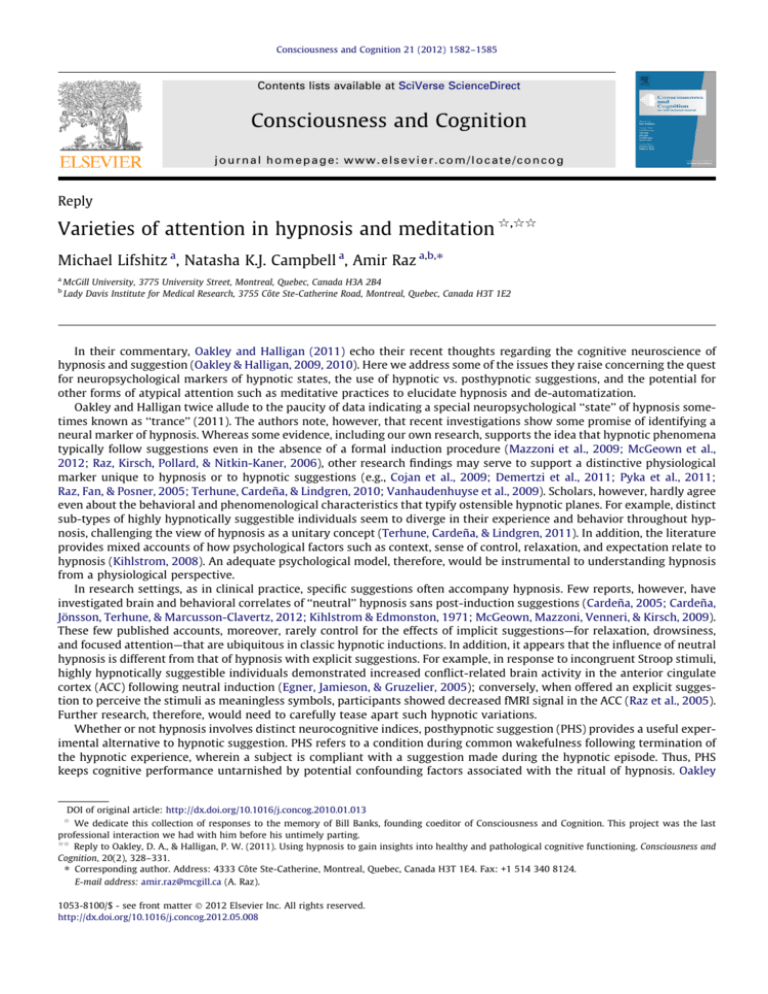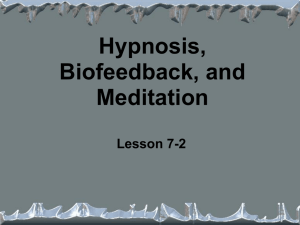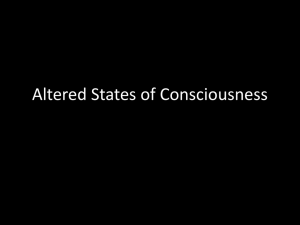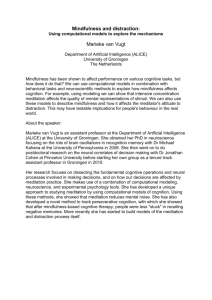
Consciousness and Cognition 21 (2012) 1582–1585
Contents lists available at SciVerse ScienceDirect
Consciousness and Cognition
journal homepage: www.elsevier.com/locate/concog
Reply
Varieties of attention in hypnosis and meditation q,qq
Michael Lifshitz a, Natasha K.J. Campbell a, Amir Raz a,b,⇑
a
b
McGill University, 3775 University Street, Montreal, Quebec, Canada H3A 2B4
Lady Davis Institute for Medical Research, 3755 Côte Ste-Catherine Road, Montreal, Quebec, Canada H3T 1E2
In their commentary, Oakley and Halligan (2011) echo their recent thoughts regarding the cognitive neuroscience of
hypnosis and suggestion (Oakley & Halligan, 2009, 2010). Here we address some of the issues they raise concerning the quest
for neuropsychological markers of hypnotic states, the use of hypnotic vs. posthypnotic suggestions, and the potential for
other forms of atypical attention such as meditative practices to elucidate hypnosis and de-automatization.
Oakley and Halligan twice allude to the paucity of data indicating a special neuropsychological ‘‘state’’ of hypnosis sometimes known as ‘‘trance’’ (2011). The authors note, however, that recent investigations show some promise of identifying a
neural marker of hypnosis. Whereas some evidence, including our own research, supports the idea that hypnotic phenomena
typically follow suggestions even in the absence of a formal induction procedure (Mazzoni et al., 2009; McGeown et al.,
2012; Raz, Kirsch, Pollard, & Nitkin-Kaner, 2006), other research findings may serve to support a distinctive physiological
marker unique to hypnosis or to hypnotic suggestions (e.g., Cojan et al., 2009; Demertzi et al., 2011; Pyka et al., 2011;
Raz, Fan, & Posner, 2005; Terhune, Cardeña, & Lindgren, 2010; Vanhaudenhuyse et al., 2009). Scholars, however, hardly agree
even about the behavioral and phenomenological characteristics that typify ostensible hypnotic planes. For example, distinct
sub-types of highly hypnotically suggestible individuals seem to diverge in their experience and behavior throughout hypnosis, challenging the view of hypnosis as a unitary concept (Terhune, Cardeña, & Lindgren, 2011). In addition, the literature
provides mixed accounts of how psychological factors such as context, sense of control, relaxation, and expectation relate to
hypnosis (Kihlstrom, 2008). An adequate psychological model, therefore, would be instrumental to understanding hypnosis
from a physiological perspective.
In research settings, as in clinical practice, specific suggestions often accompany hypnosis. Few reports, however, have
investigated brain and behavioral correlates of ‘‘neutral’’ hypnosis sans post-induction suggestions (Cardeña, 2005; Cardeña,
Jönsson, Terhune, & Marcusson-Clavertz, 2012; Kihlstrom & Edmonston, 1971; McGeown, Mazzoni, Venneri, & Kirsch, 2009).
These few published accounts, moreover, rarely control for the effects of implicit suggestions—for relaxation, drowsiness,
and focused attention—that are ubiquitous in classic hypnotic inductions. In addition, it appears that the influence of neutral
hypnosis is different from that of hypnosis with explicit suggestions. For example, in response to incongruent Stroop stimuli,
highly hypnotically suggestible individuals demonstrated increased conflict-related brain activity in the anterior cingulate
cortex (ACC) following neutral induction (Egner, Jamieson, & Gruzelier, 2005); conversely, when offered an explicit suggestion to perceive the stimuli as meaningless symbols, participants showed decreased fMRI signal in the ACC (Raz et al., 2005).
Further research, therefore, would need to carefully tease apart such hypnotic variations.
Whether or not hypnosis involves distinct neurocognitive indices, posthypnotic suggestion (PHS) provides a useful experimental alternative to hypnotic suggestion. PHS refers to a condition during common wakefulness following termination of
the hypnotic experience, wherein a subject is compliant with a suggestion made during the hypnotic episode. Thus, PHS
keeps cognitive performance untarnished by potential confounding factors associated with the ritual of hypnosis. Oakley
DOI of original article: http://dx.doi.org/10.1016/j.concog.2010.01.013
q
We dedicate this collection of responses to the memory of Bill Banks, founding coeditor of Consciousness and Cognition. This project was the last
professional interaction we had with him before his untimely parting.
qq
Reply to Oakley, D. A., & Halligan, P. W. (2011). Using hypnosis to gain insights into healthy and pathological cognitive functioning. Consciousness and
Cognition, 20(2), 328–331.
⇑ Corresponding author. Address: 4333 Côte Ste-Catherine, Montreal, Quebec, Canada H3T 1E4. Fax: +1 514 340 8124.
E-mail address: amir.raz@mcgill.ca (A. Raz).
1053-8100/$ - see front matter Ó 2012 Elsevier Inc. All rights reserved.
http://dx.doi.org/10.1016/j.concog.2012.05.008
M. Lifshitz et al. / Consciousness and Cognition 21 (2012) 1582–1585
1583
and Halligan (2011) propose that upon detecting the post-hypnotic cue, highly hypnotizable individuals might spontaneously re-enter hypnosis. One approach provides preliminary support for the hypothesis of spontaneous hypnosis (Barabasz,
2005), but this theory has been criticized on both theoretical and empirical grounds (Kirsch et al., 2008). More likely, therefore, PHS allows participants to carry out responses during a typical experience of wakefulness, albeit with some attention
resources allocated to the processing of suggestion (Tobis & Kihlstrom, 2010).
We concur with Oakley and Halligan that it would be important to study hypnosis and de-automatization in a wider
context. The preponderance of the evidence demonstrates that typical and atypical attention (e.g., suggestion) comprise
intersecting organ systems (Raz, 2005). Such top-down processes draw on overlapping neural circuitry, functional neuroanatomy, chemical modulators, and cellular structures (Fernandez-Duque & Posner, 2001; Posner & Fan, 2004; Raz, 2006;
Raz, Lamar, Buhle, Kane, & Peterson, 2007). Thus, the association between suggestion and attention has been affirmed both
theoretically and empirically (Raz, 2004, 2005, 2006, 2007, 2008; Raz & Buhle, 2006; Raz & Campbell, 2011; Raz et al., 2007).
Probing the relationship between hypnosis and other forms of atypical attention may elucidate the processes underlying
cognitive control. One such set of insights comes from the investigation of meditative practices.
Most forms of meditation share the essential feature of attention regulation. The word meditation describes a broad range
of practices aimed at cultivating particular attentional sets to increase cognitive control, promote well-being, and achieve
existential insight. Drawing on traditional Buddhist perspectives, scientists generally classify meditation practices into
two non-exhaustive categories: focused attention and open monitoring (Lutz, Slagter, Dunne, & Davidson, 2008). Focused
attention involves sustained narrowing of attention on an experiential object such as the breath or a mantra. Open
monitoring, on the other hand, involves non-discriminatory broadening of attention to include the whole field of
moment-to-moment experience. Many meditative techniques draw on both focused attention and open monitoring to
cultivate a non-judgmental, receptive awareness of the present moment.
De-automatization is a central theme pervading historical, phenomenological, and scientific accounts of meditative practice. Traditional Buddhist sources, which inspire much of the recent empirical work on this topic, construe meditation as a
group of techniques geared at refining attention and meta-awareness with the goal of releasing unwholesome habits of
thought and behavior (Gunaratana, 2002; Lutz, Dunne, & Davidson, 2006). Accordingly, studies indicate that meditation
training may improve attention and executive control (Brefczynski-Lewis, Lutz, Schaefer, Levinson, & Davidson, 2007;
MacLean et al., 2010; Slagter et al., 2007; Tang et al., 2007; but see Jensen, Vangkilde, Frokjaer, & Hasselbalch, 2012), override
involuntary emotional reactivity (Farb et al., 2010; Taylor et al., 2011), and alter the experience and neural expression of pain
(Brown & Jones, 2010; Gard et al., 2011; Grant, Courtemanche, & Rainville, 2011; Zeidan et al., 2011). Meditative practices,
moreover, may reduce the automaticity of mind-wandering (Mrazek, Smallwood, & Schooler, 2012) and alter connectivity
within the default-mode network of the brain (Brewer et al., 2011; Farb et al., 2007; Hasenkamp & Barsalou, 2012; Jang
et al., 2011; Josipovic, Dinstein, Weber, & Heeger, 2012; Pagnoni, 2012; Pagnoni, Cekic, & Guo, 2008; Taylor et al., 2012). Such
functional and behavioral alterations manifest alongside volumetric, morphometric, and tractographic changes in brain
structure (Grant, Courtemanche, Duerden, Duncan, & Rainville, 2010; Hölzel et al., 2011; Kang et al., 2012; Lazar et al.,
2005; Luders, Clark, Narr, & Toga, 2011; Luders, Kurth et al., 2012; Luders, Phillips et al., 2012; Pagnoni & Cekic, 2007; Tang
et al., 2010). Thus, similar to hypnosis, meditation provides a promising vehicle for exploring the top-down modulation, and
even transformation, of deeply-ingrained processes.
Comparing de-automatization across both hypnosis and meditation may help illuminate the neural underpinnings of cognitive control. Parallel to our findings involving suggestion, some studies indicate that meditation may lead to reductions in
Stroop interference effects (Alexander, Langer, Newman, Chandler, & Davies, 1989; Chan & Woollacott, 2007; Moore &
Malinowski, 2009; Wenk-Sormaz, 2005). Oakley and Halligan aptly remark that ‘‘an important aim for future studies of hypnotically induced inhibition of the word/color Stroop effect will be to discover at what stage in the reading process the assumed attentionally mediated effect (the suggested deficit) produced its impact’’ (2011, p. 2). We investigated this question
several years ago using combined fMRI and electrical scalp recording. A specific posthypnotic suggestion to perceive the
printed words as meaningless symbols of a foreign language produced a general dampening of visual processing in the extra-striate cortex as early as 150 ms following stimulus presentation, along with reduced fMRI signal in the ACC (Raz et al.,
2005). Preliminary efforts have begun to explore the brain correlates of ballistic processes, such as the Stroop, among practitioners of meditation (Kozasa et al., 2012; Moore, Gruber, Derose, & Malinowski, 2012; Teper & Inzlicht, 2012). One recent
study documented that, compared with participants who were naïve to meditation, long-term meditators with experience in
a variety of FA and OM practices demonstrated reduced ACC activity in response to incongruent Stroop stimuli (Kozasa et al.,
2012). These results mirror our findings with posthypnotic suggestion (Raz et al., 2005) and intimate that certain meditative
practices may override the automaticity of word reading in a Stroop context. Future studies examining de-automatization in
both hypnosis and meditation would be instrumental to elucidating the similarities, differences, and neurocognitive substrates of these unique and overlapping forms of self-regulation.
References
Alexander, C., Langer, E., Newman, R., Chandler, H., & Davies, J. (1989). Transcendental Meditation, mindfulness, and longevity: An experimental study with
the elderly. Journal of Personality and Social Psychology, 57(6), 950–964.
Barabasz, A. F. (2005). Whither spontaneous hypnosis: A critical issue for practitioners and researchers. American Journal of Clinical Hypnosis, 48(2–3), 91–97.
Brefczynski-Lewis, J. A., Lutz, A., Schaefer, H. S., Levinson, D. B., & Davidson, R. J. (2007). Neural correlates of attentional expertise in long-term meditation
practitioners. Proceedings of the National Academy of Sciences of the United States of America, 104(27), 11483–11488.
1584
M. Lifshitz et al. / Consciousness and Cognition 21 (2012) 1582–1585
Brewer, J. A., Worhunsky, P. D., Gray, J. R., Tang, Y.-Y., Weber, J., & Kober, H. (2011). Meditation experience is associated with differences in default mode
network activity and connectivity. Proceedings of the National Academy of Sciences of the United States of America, 108(50), 20254–20259.
Brown, C. A., & Jones, A. K. P. (2010). Meditation experience predicts less negative appraisal of pain: Electrophysiological evidence for the involvement of
anticipatory neural responses. Pain, 150(3), 428–438.
Cardeña, E. (2005). The phenomenology of deep hypnosis: Quiescent and physically active. International Journal of Clinical and Experimental Hypnosis, 53(1),
37–59.
Cardeña, E., Jönsson, P., Terhune, D. B., & Marcusson-Clavertz, D. (2012). The neurophenomenology of neutral hypnosis. Cortex.
Chan, D., & Woollacott, M. (2007). Effects of level of meditation experience on attentional focus: Is the efficiency of executive or orientation networks
improved? Journal of Alternative and Complementary Medicine, 13(6), 651–657.
Cojan, Y., Waber, L., Schwartz, S., Rossier, L., Forster, A., & Vuilleumier, P. (2009). The brain under self-control: Modulation of inhibitory and monitoring
cortical networks during hypnotic paralysis. Neuron, 62(6), 862–875.
Demertzi, A., Soddu, A., Faymonville, M. E., Bahri, M. A., Gosseries, O., Vanhaudenhuyse, A., et al (2011). Hypnotic modulation of resting state fMRI default
mode and extrinsic network connectivity. In E. J. W. van Someren, Y. D. van der Werf, P. R. Roelfsema, H. D. Mansvelder, & F. H. Lopes Da Silva (Eds.).
Progress in brain research (Vol. 193, pp. 309–322). Elsevier.
Egner, T., Jamieson, G., & Gruzelier, J. (2005). Hypnosis decouples cognitive control from conflict monitoring processes of the frontal lobe. NeuroImage, 27(4),
969–978.
Farb, N. A. S., Anderson, A. K., Mayberg, H., Bean, J., McKeon, D., & Segal, Z. V. (2010). Minding one’s emotions: Mindfulness training alters the neural
expression of sadness. Emotion, 10(1), 25–33.
Farb, N. A. S., Segal, Z. V., Mayberg, H., Bean, J., McKeon, D., Fatima, Z., et al (2007). Attending to the present: Mindfulness meditation reveals distinct neural
modes of self-reference. Social Cognitive and Affective Neuroscience, 2(4), 313–322.
Fernandez-Duque, D., & Posner, M. I. (2001). Brain imaging of attentional networks in normal and pathological states. Journal of Clinical and Experimental
Neuropsychology, 23(1), 74–93.
Gard, T., Hölzel, B. K., Sack, A. T., Hempel, H., Lazar, S. W., Vaitl, D., et al (2011). Pain attenuation through mindfulness is associated with decreased cognitive
control and increased sensory processing in the brain. Cerebral Cortex.
Grant, J. A., Courtemanche, J., Duerden, E. G., Duncan, G. H., & Rainville, P. (2010). Cortical thickness and pain sensitivity in zen meditators. Emotion, 10(1),
43–53.
Grant, J. A., Courtemanche, J., & Rainville, P. (2011). A non-elaborative mental stance and decoupling of executive and pain-related cortices predicts low pain
sensitivity in Zen meditators. Pain, 152(1), 150–156.
Gunaratana, H. (2002). Mindfulness in plain English. Boston, MA: Wisdom Publications.
Hasenkamp, W., & Barsalou, L. W. (2012). Effects of meditation experience on functional connectivity of distributed brain networks. Frontiers in Human
Neuroscience, 6.
Hölzel, B. K., Carmody, J., Vangel, M., Congleton, C., Yerramsetti, S. M., Gard, T., et al (2011). Mindfulness practice leads to increases in regional brain gray
matter density. Psychiatry Research: Neuroimaging, 191(1), 36–43.
Jang, J. H., Jung, W. H., Kang, D.-H., Byun, M. S., Kwon, S. J., Choi, C.-H., et al (2011). Increased default mode network connectivity associated with meditation.
Neuroscience Letters, 487(3), 358–362.
Jensen, C. G., Vangkilde, S., Frokjaer, V., & Hasselbalch, S. G. (2012). Mindfulness training affects attention—Or is it attentional effort? Journal of Experimental
Psychology: General, 141(1), 106–123.
Josipovic, Z., Dinstein, I., Weber, J., & Heeger, D. J. (2012). In fluence of meditation on anti-correlated networks in the brain. Frontiers in Human Neuroscience,
5.
Kang, D. H., Jo, H. J., Jung, W. H., Kim, S. H., Jung, Y.-H., Choi, C.-H., et al (2012). The effect of meditation on brain structure: Cortical thickness mapping and
diffusion tensor imaging. Social Cognitive and Affective Neuroscience.
Kihlstrom, J. F., & Edmonston, W. E. (1971). Alterations in consciousness in neutral hypnosis: Distortions in semantic space. American Journal of Clinical
Hypnosis, 13(4), 243–248.
Kihlstrom, J. F. (2008). The domain of hypnosis, revisited. In M. Nash & A. Barnier (Eds.), Oxford handbook of hypnosis (pp. 21–52). Oxford: Oxford University.
Kirsch, I., Mazzoni, G., Roberts, K., Dienes, Z., Hallquist, M. N., Williams, J., et al (2008). Slipping into trance. Contemporary Hypnosis, 25(3-4), 202–209.
Kozasa, E. H., Sato, J. R., Lacerda, S. S., Barreiros, M. A. M., Radvany, J., Russell, T. A., et al (2012). Meditation training increases brain efficiency in an attention
task. NeuroImage, 59(1), 745–749.
Lazar, S. W., Kerr, C. E., Wasserman, R. H., Gray, J. R., Greve, D. N., Treadway, M. T., et al (2005). Meditation experience is associated with increased cortical
thickness. Neuroreport, 16(17), 1893–1897.
Luders, E., Clark, K., Narr, K. L., & Toga, A. W. (2011). Enhanced brain connectivity in long-term meditation practitioners. NeuroImage, 57(4), 1308–1316.
Luders, E., Kurth, F., Mayer, E. A., Toga, A. W., Narr, K. L., & Gaser, C. (2012). The unique brain anatomy of meditation practitioners: Alterations in cortical
gyrification. Frontiers in Human Neuroscience, 6.
Luders, E., Phillips, O. R., Clark, K., Kurth, F., Toga, A. W., & Narr, K. L. (2012). Bridging the hemispheres in meditation: Thicker callosal regions and enhanced
fractional anisotropy (FA) in long-term practitioners. NeuroImage.
Lutz, A., Dunne, J. D., & Davidson, R. J. (2006). Meditation and the neuroscience of consciousness: An introduction. In P. D. Zelazo, M. Moscovitch, & E.
Thompson (Eds.), Cambridge handbook of consciousness. New York, NY: Cambridge University Press.
Lutz, A., Slagter, H. A., Dunne, J. D., & Davidson, R. J. (2008). Attention regulation and monitoring in meditation. Trends in Cognitive Sciences, 12(4), 163–169.
MacLean, K. A., Ferrer, E., Aichele, S. R., Bridwell, D. A., Zanesco, A. P., Jacobs, T. L., et al (2010). Intensive meditation training improves perceptual
discrimination and sustained attention. Psychological Science, 21(6), 829.
Mazzoni, G., Rotriquenz, E., Carvalho, C., Vannucci, M., Roberts, K., & Kirsch, I. (2009). Suggested visual hallucinations in and out of hypnosis. Consciousness
and Cognition, 18(2), 494–499.
McGeown, W. J., Mazzoni, G., Venneri, A., & Kirsch, I. (2009). Hypnotic induction decreases anterior default mode activity. Consciousness and Cognition, 18(4),
848–855.
McGeown, W. J., Venneri, A., Kirsch, I., Nocetti, L., Roberts, K., Foan, L., et al (2012). Suggested visual hallucination without hypnosis enhances activity in
visual areas of the brain. Consciousness and Cognition, 21(1), 100–116.
Moore, A. W., Gruber, T., Derose, J., & Malinowski, P. (2012). Regular, brief mindfulness meditation practice improves electrophysiological markers of
attentional control. Frontiers in Human Neuroscience, 6.
Moore, A. W., & Malinowski, P. (2009). Meditation, mindfulness and cognitive flexibility. Consciousness and Cognition, 18(1), 176–186.
Mrazek, M. D., Smallwood, J., & Schooler, J. W. (2012). Mindfulness and mind-wandering: Finding convergence through opposing constructs. Emotion.
Oakley, D. A., & Halligan, P. W. (2009). Hypnotic suggestion and cognitive neuroscience. Trends in Cognitive Sciences, 13(6), 264–270.
Oakley, D. A., & Halligan, P. W. (2011). Using hypnosis to gain insights into healthy and pathological cognitive functioning. Consciousness and Cognition,
20(2), 328–331.
Oakley, D. A., & Halligan, P. W. (2010). Psychophysiological foundations of hypnosis and suggestion. In J. L. Steven, J. W. Rhue, & I. Kirsch (Eds.), Handbook of
clinical hypnosis (2nd ed. Washington, DC: American Psychological Association.
Pagnoni, G. (2012). Dynamical properties of BOLD activity from the ventral posteromedial cortex associated with meditation and attentional skills. The
Journal of Neuroscience, 32(15), 5242–5249.
Pagnoni, G., & Cekic, M. (2007). Age effects on gray matter volume and attentional performance in Zen meditation. Neurobiology of Aging, 28(10),
1623–1627.
Pagnoni, G., Cekic, M., & Guo, Y. (2008). ‘‘Thinking about not-thinking’’: Neural correlates of conceptual processing during Zen meditation. PLoS ONE, 3(9).
M. Lifshitz et al. / Consciousness and Cognition 21 (2012) 1582–1585
1585
Posner, M. I., & Fan, J. (2004). Attention as an organ system. In J. R. Pomerantz & M. C. Crair (Eds.), Topics in integrative neuroscience. From cells to cognition.
Cambridge, UK: Cambridge University Press.
Pyka, M., Burgmer, M., Lenzen, T., Pioch, R., Dannlowski, U., Pfleiderer, B., et al (2011). Brain correlates of hypnotic paralysis—A resting-state fMRI study.
NeuroImage, 56(4), 2173–2182.
Raz, A. (2004). Anatomy of attentional networks. Anatomical Record B New Anatomist, 281(1), 21–36.
Raz, A. (2005). Attention and hypnosis: neural substrates and genetic associations of two converging processes. International Journal of Clinical and
Experimental Hypnosis, 53(3), 237–258.
Raz, A. (2006). Individual differences and attentional varieties. Eura Medicophys, 42(1), 53–58.
Raz, A. (2007). Suggestibility and hypnotizability: mind the gap. American Journal of Clinical Hypnosis, 49(3), 205–210.
Raz, A. (2008). Genetics and neuroimaging of attention and hypnotizability may elucidate placebo. International Journal of Clinical and Experimental Hypnosis,
56(1), 99–116.
Raz, A., & Buhle, J. (2006). Typologies of attentional networks. Nature Reviews Neuroscience, 7(5), 367–379.
Raz, A., & Campbell, N. K. J. (2011). Can suggestion obviate reading? Supplementing primary Stroop evidence with exploratory negative priming analyses.
Consciousness and Cognition, 20(2), 312–320.
Raz, A., Fan, J., & Posner, M. I. (2005). Hypnotic suggestion reduces conflict in the human brain. Proceedings of the National Academy of Sciences of the United
States of America, 102(28), 9978–9983.
Raz, A., Kirsch, I., Pollard, J., & Nitkin-Kaner, Y. (2006). Suggestion reduces the Stroop effect. Psychological Science, 17(2), 91–95.
Raz, A., Lamar, M., Buhle, J. T., Kane, M. J., & Peterson, B. S. (2007). Selective biasing of a specific bistable-figure percept involves fMRI signal changes in
frontostriatal circuits: A step toward unlocking the neural correlates of top-down control and self-regulation. American Journal of Clinical Hypnosis, 50(2),
137–156.
Slagter, H. A., Lutz, A., Greischar, L. L., Francis, A. D., Nieuwenhuis, S., Davis, J. M., et al (2007). Mental training affects distribution of limited brain resources.
PLoS Biology, 5(6), e138.
Tang, Y. Y., Lu, Q., Geng, X., Stein, E. A., Yang, Y., & Posner, M. I. (2010). Short-term meditation induces white matter changes in the anterior cingulate.
Proceedings of the National Academy of Sciences of the United States of America, 107(35), 15649–15652.
Tang, Y. Y., Ma, Y. H., Wang, J., Fan, Y. X., Feng, S. G., Lu, Q. L., et al (2007). Short-term meditation training improves attention and self-regulation. Proceedings
of the National Academy of Sciences of the United States of America, 104, 17152–17156.
Taylor, V. A., Daneault, V., Grant, J., Scavone, G., Breton, E., Roffe-Vidal, S., et al (2012). Impact of meditation training on the default mode network during a
restful state. Social Cognitive and Affective Neuroscience.
Taylor, V. A., Grant, J., Daneault, V., Scavone, G., Breton, E., Roffe-Vidal, S., et al (2011). Impact of mindfulness on the neural responses to emotional pictures
in experienced and beginner meditators. NeuroImage, 57(4), 1524–1533.
Teper, R., & Inzlicht, M. (2012). Meditation, mindfulness, and executive control: The importance of emotional acceptance and brain-based performance
monitoring. Social Cognitive and Affective Neuroscience.
Terhune, D. B., Cardeña, E., & Lindgren, M. (2010). Disruption of synaesthesia by posthypnotic suggestion: An ERP study. Neuropsychologia, 48(11),
3360–3364.
Terhune, D. B., Cardeña, E., & Lindgren, M. (2011). Dissociated control as a signature of typological variability in high hypnotic suggestibility. Consciousness
and Cognition, 20(3), 727–736.
Tobis, I. P., & Kihlstrom, J. F. (2010). Allocation of attentional resources in posthypnotic suggestion. International Journal of Clinical and Experimental Hypnosis,
58(4), 367–382.
Vanhaudenhuyse, A., Boly, M., Balteau, E., Schnakers, C., Moonen, G., Luxen, A., et al (2009). Pain and non-pain processing during hypnosis: A thulium-YAG
event-related fMRI study. NeuroImage, 47(3), 1047–1054.
Wenk-Sormaz, H. (2005). Meditation can reduce habitual responding. Alternative Therapies in Health and Medicine, 11(2), 42–59.
Zeidan, F., Martucci, K. T., Kraft, R. A., Gordon, N. S., McHaffie, J. G., & Coghill, R. C. (2011). Brain mechanisms supporting the modulation of pain by
mindfulness meditation. The Journal of Neuroscience, 31(14), 5540–5548.








